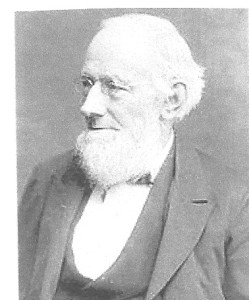One of the inevitable consequences of the Industrial Revolution was the growth in the commercial, clerical and administrative support that business organisations required. The history of the developments and the individuals associated with the creation of commercial and business processes is as interesting as the history of technical education. During the 18th century manufacturing, commercial and financial services enterprises, both small and large, developed at a rapid rate. The need to communicate increased exponentially and this necessitated more efficient and effective methods of managing business correspondence to customers and clients. Whether in cotton mills, heavy industrial companies, the rapidly expanding civil service and the military, managers increasingly wanted a quicker way of recording their instructions to their staff/secretaries before these records were composed and transcribed into appropriate correspondence or other commercial/business documents.
Samuel Taylor had developed a shorthand system in 1786, which was based on an earlier system devised by John Byrom. However it was the system created by Isaac Pitman that was to revolutionise this important and essential aid to commercial and business activity.
The defining characteristics of Isaac Pitman and indeed his brothers were very similar to those of the other great pioneers of the Industrial revolution largely self-taught, highly motivated, hard working, very innovative and creative. He was born in Trowbridge in 1813; son of a hand loom weaver, leaving school reluctantly at 13 and then worked as a clerk in a textile mill. However in spite of working 12 hour days he and his brother Jacob studied at home before going to work at 6 am and continued studying in the evenings after work. He qualified as a teacher and taught in a number of schools before founding his own school in Wotton-under-Edge in 1837.
It was during this period that he published his book ‘Stenographic Sound-Hand’ in 1837 followed in 1840 by ‘Phonography’ the latter publication often referred to as the Penny Plate. This publication become the first correspondence course and was initially free of charge – the penny was just the cost of the postage. Pitman was passionate about education most of all and wanted to “educate anyone of any class from anywhere who could read and had a desire to learn”
These seminal publications laid the foundations for his famous shorthand system which was adopted worldwide ultimately and translated into over thirty languages.
The Pitman approach like the earlier and later shorthand systems was based on the phonetic system namely the symbols represent sounds as opposed to letters and are mainly written as the words are spoken. The Pitman system quickly became the most popular and widely used shorthand in Britain, the US and around the world. In 1870 he opened the Pitman’s Metropolitan College probably the first business education school in the world. The Pitman shorthand system was adopted by the parliamentary stenographers to prepare Hansard. He founded a company called Sir Isaac Pitman and Sons which became one of the world’s leading educational publishing and training businesses.
His brothers greatly assisted the cascading of the system and were remarkable individuals in their own right. Benn went to America in 1853 and introduced the shorthand to the country and later became a famous engraver, court reporter and then entered the world of design, working to develop art and design education in America. He reported many famous court cases including the trial of the assassin of President Lincoln. Benn published extensively reflecting his interests and court experiences. Jacob went to Australia in 1837 where he too introduced the Pitman’s shorthand system whilst pursuing his initial training as a builder and architect specialising in building bridges.
Isaac Pitman was a perfectionist and continually revised and improved the system over many years up to his death in 1897 leaving a system which today is still widely respected and used throughout the world.
Sir Isaac Pitman’s grandson James Pitman, born in 1901, continued the family business and was chairman and joint managing director of the Pitman Press and Pitman Publishing companies. His career included the civil service, publishing, politician (representing Bath) and spelling reformer. He invented the Initial Teaching Alphabet (ITA) and wrote extensively on the teaching of English. He served on the Management Committee of the Institute of Education, London and was Pro-Chancellor of the University of Bath.
A remarkable family.
A short chronology of the development of shorthand and stenography:
1588. ‘Characterie: An Arte of Shorte, Swifte and Secrete Writing by Character.’ T. Bright.
1602. ‘Art of Stenography’ by J. Willis published.
1742. Byrom’s shorthand system copyrighted.
1767. ‘Universal English Shorthand’ by Byrom published.
1786. ‘Essay to establish standard for a universal system of stenography’ by S. Taylor published.
1810. Jacob Pitman born (died in 1890).
1813. Isaac Pitman born (died 1897).
1822. Benn Pitman born (died 1910).
1829. Isaac Pitman took up Taylor’s system.
1837. ‘Stenography Sound-Hand’ by Pitman published. Pitman shorthand became the first subject to be taught by correspondence. Jacob Pitman introduced system in Australia.
1839. Phonetic Institute opened in Bath by Isaac Pitman.
1843 Phonographic Correspondence Society created in the UK.
1845. Isaac Pitman established his first printing press.
1851. Isaac Pitman won bronze medal at the Great Exhibition.
1852. Benn Pitman introduced the Pitman system in America.
1864. The (R)SA introduces shorthand examinations.
1870. Pitman’s Metropolitan School opened in London.
1888. Oxford Local Examining Board introduces shorthand examinations.
1889. Pitman system was recognised by the government in the “Technical Instruction Act”.
1894. Isaac Pitman knighted.
1921. Pitman Commercial Examinations Department created.
References:
Baker. A. ‘The Life of Sir Isaac Pitman (Inventer of Phonography).’ ISBN-13 978-1178 384147. Nabu Press 2010.
Pitman. B. ‘Sir Isaac Pitman. Life and Labours’. ISBN-13 978-05480 46944. Kessinger Press. 2007.
Encyclopedia Britannica. Sir Isaac Pitman.


I am a Pitman skilled person way back in 1982-1984. Wanted to know who owns copyright for Pitman Shorthand in the current year